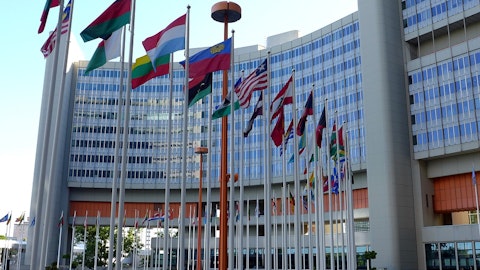Marriott International, Inc. (NASDAQ:MAR) Q4 2023 Earnings Call Transcript February 13, 2024
Marriott International, Inc. beats earnings expectations. Reported EPS is $3.57, expectations were $2.12. Marriott International, Inc. isn’t one of the 30 most popular stocks among hedge funds at the end of the third quarter (see the details here).
Operator: Good day, everyone and welcome to today’s Marriott International Q4 2023 Earnings Call. At this time, all participants are in a listen-only mode. Later, you will have an opportunity to ask questions during the question-and-answer session. [Operator Instructions]. Please note this call is being recorded and I’ll be standing by should you need any assistance. It is now my pleasure to turn today’s program over to Jackie McConagha.
Jackie McConagha: Thank you. Good morning everyone and welcome to Marriott’s fourth quarter 2023 earnings call. On the call with me today are Tony Capuano, our President and Chief Executive Officer; Leeny Oberg, our Chief Financial Officer and Executive Vice President, Development; and Betsy Dahm, our Vice President of Investor Relations. Before we begin, I would like to remind everyone that many of our comments today are not historical facts and are considered forward-looking statements under Federal Securities Laws. These statements are subject to numerous risks and uncertainties as described in our SEC filings, which could cause future results to differ materially from those expressed in or implied by our comments. Please also note that our discussion of revenues across different customer segments refer to property level revenues and unless otherwise stated, our RevPAR occupancy, ADR, and property level revenue comments reflect system-wide constant currency results for comparable hotels.
Statements in our comments and the press release we issued earlier today are effective only today and will not be updated as actual events unfold. You can find our earnings release and reconciliations of all non-GAAP financial measures referred to in our remarks today on our Investor Relations website. And now, I will turn the call over to Tony.
Anthony Capuano: Thank you Jackie and good morning everyone. Our team produced fantastic results in 2023. We continued to experience strong momentum in our business around the world thanks to solid demand for travel and our diverse portfolio of 30 plus leading brands. Full year of global RevPAR rose nearly 15% and net rooms grew 4.7% leading to excellent earnings and cash flow growth. In the fourth quarter global RevPAR increased over 7% year-over-year driven by roughly equal gains in the ADR and occupancy. Group which comprised of 23% room nights was again the standout customer set. Compared to the year ago quarter Group revenues rose 9% globally and 7% in the U.S. and Canada. And Group is shaping up to have another solid year in 2024.
At the end of last year, full year 2024 Group revenues were pacing up nearly 13% globally and 11% in the U.S. and Canada on a year-over-year basis, driven by robust increases in both room nights and ADR. Leisure transient accounted for 44% of global rooms nights in the quarter. This segment has by far grown the fastest coming out of COVID. With global leisure transient revenues in the fourth quarter, nearly 50% above the same quarter in 2019. Even with this strong growth, demand has remained resilient. Fourth quarter global room nights rose 5% over the year ago quarter, leading to a 6% leisure transient revenue growth worldwide. In the U.S. and Canada, leisure revenues were up 2%. Business transient contributed 33% of global room nights in the fourth quarter.
Demand from small and medium-sized corporates remained robust, and while large corporates are still lagging, they continue to post volume increases. Solid gains in ADR drove business transient revenues of 7% globally and 3% in the U.S. and Canada. Our powerful Marriott Bonvoy loyalty program grew to over 196 million members at the end of the year. Member penetration of global room nights reached new highs in the fourth quarter at 69% in the U.S. and Canada and 62% global. Our digital channels and mobile in particular remain key drivers of growth at a lower cost to our owners. Our Marriott Bonvoy app contributed 22% more room nights in 2023 than in the prior year. We are focused on improving the customer experience across all our digital and other booking channels through the multi-year technology transformation we have underway.
Enhancing engagement with our members outside of hotel stays through our numerous successful Marriott Bonvoy collaborations, including our co-branded credit cards also remains a priority. Our growing portfolio of 31 credit cards across 11 countries had record global card member acquisitions last year, and card spend for the year grew 11%. On the development front, despite a challenging financing environment in the U.S. and Europe, we signed a record 891 organic management, franchise, and license agreements in 2023, representing approximately 164,000 rooms. Additionally, we ended the year with a new high of roughly 573,000 rooms in our pipeline. We expect another year of strong global signings in 2024 and are already off to an incredible start.
We also saw a meaningful acceleration in net rooms growth last year to 4.7%, the highest growth since 2019. Conversions helped again in 2023, accounting for 25% of organic room additions and 40% of organic room signings. For 2024, we anticipate net rooms growth of 5.5% to 6%. This includes around 37,000 rooms from MGM. The first set of these rooms at New York, New York became available on our Marriott channels at the end of January, with the remaining properties expected to be available by the middle of March. While it is very early days, we are incredibly pleased with the initial booking pace. We’re excited about adding these amazing properties to our portfolio and enhancing our distribution in Las Vegas and other cities across the U.S. We remain confident in the three-year net rooms compound annual growth rate we discussed at our investor meeting in September of 5% to 5.5% from year-end 2022 to year-end 2025.
As we focus on expanding our lodging offerings for owners, franchisees, and guests, we’re making significant progress globally in the high-growth, mid-scale space. We are in numerous deal discussions for Citi Express in the Caribbean and Latin America, or CALA region, and for Four Points Express in Europe, the Middle East, and Africa. Here in the U.S. we celebrated the first groundbreaking for StudioRes in Fort Myers, Florida in January and have over 300 additional potential deals under discussion in around 150 markets. As we strive to offer more options for our stakeholders, we’re also working on a new U.S. transient mid-scale brand for both new build and conversions. At the other end of the chain scale, our luxury distribution is currently over 50% larger than our next closest competitor and that lead is expanded.
In 2023, we have record luxury signings with 58 new deals and we added 29 new luxury hotels to our portfolio. In closing, 2023 was a banner year for Marriott, and I am optimistic about what lies ahead. The demand for all types of travel remains strong, even as the rebound impact from the pandemic has waned. The fundamentals for our industry are outstanding, and we are determined to grow our industry-leading position. We remain focused on offering the best brands and experiences to the most valuable and engaged guests while expanding the broadest and deepest portfolio of global properties and offerings so we can continue to connect people around the world through the power of travel. I want to thank our Marriott teams around the world for their remarkable dedication and excellent work.

And now, let me turn the call over to Leeny to discuss our financial results in more detail.
Leeny Oberg: Thank you, Tony. I’ll walk you through our strong 2023 financial results. In the fourth quarter, U.S. and Canada RevPAR increased over 3% year-over-year, primarily due to higher ADR. International RevPAR rose 17%, driven by an 8 percentage point gain in occupancy and a 4% rise in ADR. Asia Pacific again experienced the largest year-over-year RevPAR increase. RevPAR rose 81% in Greater China helped by the last quarter of easy comparisons to COVID lockdowns in the year ago quarter and grew 13% in Asia Pacific, excluding China. Fourth quarter total gross fee revenues grew 10% to 1.24 billion reflecting higher RevPAR, room additions, and strong growth in our co-brand credit card fees. Incentive management fees or IMF rose 17%, reaching 218 million driven by another quarter of significant increases in Asia Pacific.
For the full year, gross fees rose 18% with record IMFs that were nearly 20% higher than our prior peak in 2019. Owned lease and other revenue net of direct expenses reached 151 million in the quarter and included substantially higher termination fees, primarily due to 63 million associated with the termination of a development project. G&A of 330 million was impacted by a $27 million litigation reserve for an international hotel, as well as timing of performance-related compensation, an increase in bad debt expense, and higher professional fees, which included costs associated with our intellectual property restructuring transactions. Fourth quarter, adjusted EBITDA grew 10% to nearly 1.2 billion. For the full year, adjusted EBITDA was 21% higher than in 2022.
Thanks to our team’s excellent tax planning efforts that reflect evolving global tax laws, we had a tax benefit of $267 million in the quarter. This was due to over $400 million of favorable discrete items related to international IP restructuring strategies and the release of a tax valuation allowance. The fourth quarter effective tax rate was slightly higher than last year’s and above our previous expectations due to jurisdictional mixed shift. At the hotel level, despite meaningful wage and benefit inflation, we maintained profit margins in our U.S. managed hotels in the quarter and for the year compared to both 2022 and 2019, a strong performance. Importantly, our guest surveys indicate that customer satisfaction continues to rise. In December, our intent to recommend score achieved its highest monthly score in over five years.
Our asset-light business model once again generated significant cash with almost $3.2 billion of cash provided by operating activities in 2023 of 34% year-over-year. Our loyalty program was a source of cash even after factoring in the final year of reduced payments from the credit card companies resulting from the amendments we entered into in 2020. In 2024, we expect loyalty cash flow to be roughly neutral. Now let’s talk more about 2024. Our full year outlook assumes a steady, albeit slower growing, global economy. It also reflects normalized lodging demand in most regions around the world, with Asia Pacific expected to see higher growth in other regions as it continues to have some benefit from COVID recovery, as well as additional international airlift.
In 2024, RevPAR growth is expected to be driven by another meaningful increase in group revenue, continued improvement in business transient demand, which will be helped by mid-single-digit special corporate rate increases, and slower but still growing leisure revenues. We’re off to a strong start with January RevPAR up 7% globally, reflecting continued strong demand around the world, potentially in international markets. International RevPAR rose 14% and U.S. and Canada RevPAR increased 4% in the month. With year-over-year comparisons easiest in January and Easter shifting from April to March this year, global RevPAR for the first quarter could increase 4% to 5%. For the full year, we anticipate a 3% to 5% rise in global RevPAR. Growth is expected to remain higher in international markets than in the U.S. and Canada, with particular strength in Asia Pacific.
The sensitivity of a 1% change in full year 2024 RevPAR versus 2023 could be around 50 million to 60 million of RevPAR related fees. For the full year, gross fees could rise 6% to 8% to 5.1 billion to 5.2 billion with non-RevPAR related fees rising 9% to 10% driven by strong credit card and residential branding fee growth. Owned, leased, and other revenues net of expenses are expected to total 320 million to 330 million, 17% to 20% lower than 2023 due to meaningfully lower termination fees given the large termination fee in the fourth quarter of 2023, a property we sold last summer, and CALA flipping from owned to managed, and renovations at several owned hotels. We expect 2024 G&A expense could be flat to up 2% year-over-year. There are a few discrete one-time items from 2023 that are expected to offset wage and benefit increases.
Full year adjusted EBITDA could increase between 5% and 8% to roughly 4.9 billion to 5 billion. Note that our 2024 effective tax rate is expected to be around 25% while we expect our underlying core cash tax rate to remain in the low 20% range. Guidance details for the full year and first quarter are in the press release. Please note that first quarter results are expected to be impacted by a few items. First, the timing of residential branding fees is expected to result in these non-RevPAR related fees being meaningfully lower in the first quarter but up nicely for the full year. Second, owned lease and other revenue net of expenses will be lower due to the renovations on several owned properties, as well as the CALA property that flipped from owned to managed.
And finally, G&A in the year-ago quarter benefited from several one-time items, while this year’s first quarter includes MGM integration costs. Our capital allocation philosophy remains the same. We’re committed to our investment-grade rating, investing in growth that is accretive to shareholder value, and then returning excess capital to shareholders through a combination of a modest cash dividend and share repurchases. We’re pleased with the significant value we return to shareholders in 2023 and expect strong capital returns again in 2024 [ph]. For 2024, factoring in the 500 million of required cash in the fourth quarter for the purchase of the Sheraton Grand in Chicago, capital returns to shareholders could be between $4.1 billion and $4.3 billion.
Full year investment spending could total $1 billion to $1.2 billion. This includes another year of higher than historical investment in technology, the vast majority of which is expected to be reimbursed over time. The $500 million for the Sheraton Grand Chicago consists of $200 million of CAPEX and $300 million elimination of previously reported guarantee liability. Investment spending is also expected to incorporate roughly 200 million for our owned-leased portfolio and includes spending for the renovation and the elegant portfolios in Barbados, and the completion of the W Union Square renovations. We’ll look to recycle these assets and sign long term management contracts after renovations are complete. As Tony mentioned, we’re also thrilled about our development and growth prospects both inside and outside the U.S. We continue to gain market share with 7% open rooms, and 18% of rooms under construction globally, at the end of last year.
Tony and I are now happy to take your questions. Operator.
See also 13 Highest Yielding Dividend Stocks in the Dow and 12 Best Quality Dividend Stocks To Invest In.
Q&A Session
Follow Marriott International Inc (NASDAQ:MAR)
Follow Marriott International Inc (NASDAQ:MAR)
Operator: Thank you. [Operator Instructions]. Now we’ll take our first question from Joe Greff with J.P. Morgan. Your line is now open.
Joseph Greff: Good morning, guys. Thanks for taking my questions. Leeny, I was hoping you can review the MGM transaction and what’s included in fee contributions for this year? And then if you can maybe clarify what the integration costs that you refer to in your prepared comments related to the MGM license deal?
Leeny Oberg: Yeah, sure. So it’s really a modest amount of G&A but it’s just worth noting in the year-over-year comparison in Q1, that as we expect all of those hotels to transition on to Marriott systems that will all be done in Q1. When we think about the same contribution, as we’ve talked about before, Joe, they will be coming on in Q1 and we expect that business to ramp up over the year. And there’s not a particular number that I would give you now, but just a reflection that it is related to a percentage of the hotel revenue that fits into our franchise fee model as a result of a license agreement over the year.
Joseph Greff: Great. And then I know you gave us some detail in terms of investment spend this year and that Sheraton Chicago is a big chunk of that. Is the 500 million all cash out the door, I know there’s the 200 million in CAPEX and 300 million to, I guess satisfy the getting out of that guarantee. Can you provide a little bit more clarity on that? And then [Multiple Speakers] of the billion is sort of aspirational and not spoken for at this point?
Leeny Oberg: Yeah, no, no, it’s a good clarification question, Joe. That 500 million is cash out the door and we would expect that to occur in Q4 of 2024. But to help you understand what we’re really considering capital investment, we wanted to clarify to say that 200 million of the 500 million relates to the purchase of the underlying land on the Sheraton Grand Chicago. And so that is in CAPEX, while the rest reflects a liability that we established on the balance sheets, frankly, years ago as part of the overall transaction. So it does obviously impact our available cash for the year, but it is in there. And when you think about unidentified capital expenditures in that number of the 1 to 1.2, which really is quite modest.
Joseph Greff: Great, thanks so much.
Operator: Thank you. Your next question is from Shaun Kelley from Bank of America.
Shaun Kelley: Hi, good morning everyone. Tony and Leeny, just wondering — if you could just start with maybe kind of current state of the development environment. Tony, obviously, global interest rates have cooperated a little bit for the hope of developers and just sort of what you’re — probably same thing on the construction cost landscape. So as we sit here today, I know it’s only four months or so from your big update at the Analyst Day. But could you just give us latest sense of the land, how some of those conversations went, and what people should expect on the organic side for the first signings and more importantly, probably starting to move into construction?
Anthony Capuano: Oh, of course. So, as we mentioned in the prepared remarks on the heels of a record signings year, it’s more anecdotal than anything else. But in terms of deal volume through the first month of the year it’s really encouraging. And we’re seeing strong momentum both on submissions for new build projects around the world as well as continued really encouraging momentum on the conversion side. In terms of the environment coming out of the Alice, I’m going to ramble here a little bit, because I think there are both some positives and negatives that we heard from the owner and franchisee community about their expectations for 2024. On the positive side of the ledger, as you point out, there is a sense that there will be continued relief on the interest rate side as we get in particularly the back half of 2024.
There is an expectation maybe in parallel, but the hotel transaction market will start to be a bit more active in the back half of the year as well. And while there is still admittedly some gap in the bid and the ask between sellers and buyers, it feels like that gap is continuing to narrow, which will likely lead we expect to a little more active transaction environment, which has always historically been good news for us on the conversion front. When you pivot to the more challenging side of the ledger, you do still have lenders thinking about compliance with proposed regulatory environment that will perhaps impact their ability to really open the faucet in terms of the amount of debt to date and debt financing that they make available for new construction.
But there again, it’s one of the reasons we’re so enthusiastic about our entry into midscale. When we talk to our franchise partners on the midscale front, they feel like the size of those commitments is something that they’re going to have a decent measure of success in procuring debt. And then the last thing I would remind you is the obvious debt, while we stayed very focused on the availability of debt and its impact on our growth trajectory, that is largely a U.S., Canada, and Western Europe attribute. When you look at the pace of growth we’re seeing across Asia Pacific, across the Middle East, that growth does not seem to be particularly impacted by the ups and downs, the availability of debt. I think you also had a question about construction costs and so maybe I’ll expand my answer a little bit.
When we think about potential impediments to growth, the availability of debt is the one that I think we’re most focused on. Supply chain issues, which we were talking with you about a year ago, are not nearly as severe as we saw several quarters ago. Construction costs have come down a little bit and they’re rising year-over-year at lower rates than we saw a year or two ago. So on that front, I think we’re pretty encouraged. But it’s really the ability to source debt for new construction is the area that Leeny and the team are most focused on.
Shaun Kelley: Thank you very much.
Operator: Thank you. We’ll take our next question from Smedes Rose with Citi. Your line is now open.
Smedes Rose: I was just wondering, when we look at the sort of core metrics that you guys provide in terms of EBITDA for the year, unit growth and capital return, all of those at least relative to our forecast, are in line or better and look similar for consensus forecast. But your operating EPS outlook is quite a bit lower than consensus. And I was just wondering if there’s any one or two things that you might point to that you think maybe there was a difference in sort of expectation versus what you expect to put up, because it doesn’t sound like it’s — like a tax rate issue, maybe there’s something else there?
Leeny Oberg: Yes. No, thanks Smedes very much. No, I appreciate that. Yes, tax rate is probably the biggest item when you think about it. First of all, just remember that in 2023 there is the reality of this extra termination fee. So when you look at year-over-year growth, that then impacts how you look at 2024 over 2023. And so if you adjust out for the odd balls of both the litigation reserve and the performance, the termination fee, and you take into consideration that we’ve got probably about a one point higher book tax rate, and I do emphasize it’s a book tax rate rather than cash. Our cash tax rate is essentially staying the same, thanks to the great work that the team has done in working through our global tax planning.
But when you look at it from a book perspective, it’s about a point higher overall. And you put those together and you can do your math there, and that is where you then get to something that looks from an adjusted EPS that looks on 2024 that looks close to double digits.
Smedes Rose: Okay, that’s helpful. And then I was just wondering, Tony, you just mentioned in your opening remarks that some of the large corporate group bookings continued to lag, which is something we’ve kind of heard for a while relative to smaller groups. So I was just wondering, could you maybe just talk a little bit more about what you’re hearing and maybe expecting as we go forward, do you think that’s just kind of impaired for the foreseeable future, or is it something that you think could improve over time, just maybe some more color there?
Anthony Capuano: Yes, of course. So really, my comment was that, let me break it down into two buckets. When I talked about business transient, the small and medium sized corporates, the demand coming out of those groups continues to be quite robust. And my comment about large corporates lagging is really sort of in reference to a pre-pandemic environment. But with that said, we continue to see incremental growth even coming out of the large corporates quarter-over-quarter.
Leeny Oberg: Just to be clear, that was on the transient side. On the group side, we’re actually, as we talked about on the group pace, it’s really still a very strong number. And I think to me, one of the interesting things is we’re now getting back to some of the way it looked before where 75% of the group that is on — that is — that we’re expecting in 2024, is already on the books, which if you look at that a year ago, that was only 65%. So it still really points out that, with this 11% pace that we’re looking at for 2024 and 12% for 2025 in the U.S., that actually the corporate group as well as the other types of group is still quite strong.
Smedes Rose: Great, thank you, appreciate it.
Operator: Thank you. We’ll take our next question from Richard Clarke with Bernstein. Your line is open.
Richard Clarke: Thanks very much for taking my questions. Maybe just one on the SG&A cost. You gave some color on why it was a little bit higher. But just wondering whether you can just do the bridge from the 255 guidance you gave at Q3. What wasn’t anticipated there, was it this IP restructuring, and why did that suddenly happen in Q4, and maybe some color on the bad debt, is there anything to read across from that as well?
Leeny Oberg: Right. So this is really largely about timing. We’ve taken you through the litigation reserve. And then there’s obviously the usual quarter-to-quarter fluctuations that reflect everything from closing deals and travel expense to, as you probably remember, when we go back to Q1 of 2023, we were still in the process of getting back to being fully staffed, which then ramps up during the year. And then as you know, the performance compensation — performance-related compensation then takes into consideration how the company is doing against its targets. And you put all those together and the constant analysis of your positions of receivables from all of your hotels around the world and just really reflects some timing of when they fell in Q3 versus Q4. And there again, when you think about looking at next year, you do see that we’re talking about flat to up 2%, which really reflects that there were a number of items this year.
Richard Clarke: Okay, that makes sense. Maybe if I can just ask a follow-up. Just with the CMD you gave a RevPAR guidance for the two-year stack of 3 to 6, net unit growth guidance of 4 to 5. Obviously, both of those are going to have to accelerate into 2025 to kind of get to the midpoint. Is that what you’re anticipating, that there are drivers to get RevPAR and acceleration in 2025?
Anthony Capuano: Yes. So Richard, maybe I’ll take the NAV question first. As we talked a little bit when we were together in Miami, we continue to think that, as you consider NAV it is less constructive to look at a single year and much more instructive to look at rooms growth over a multiyear period. In some ways, the MGM rooms coming into the system slipping from the back of 2023 into early 2024 is the best illustration of that. Notwithstanding MGM sliding into 2024, as you know, we ended up a little higher than anticipated in 2023 at 4.7% net unit growth. We expect to be at a meaningfully higher number this year because of the impact of the MGM openings. And when we look at the three-year CAGR that we discussed at the security analyst conference, we continue to be very confident in our ability to deliver that mid-single-digit range of about 5% to 5.5%.
Then I think just on a more macro basis, we’ve not made any major changes in terms of our longer-term outlook. We obviously have a little more visibility and clarity into this year. Now that the teams around the world have gone through all their numbers, but we’ve really not revisited anything beyond 2024 and continue to be quite confident in what we talked about from a RevPAR perspective.
Leeny Oberg: And just a reminder that when we go through the process, a lot of what we’re trying to do at the security analyst meeting is to help you understand a range from a modeling perspective, and it’s done before we go through the budgeting process. So actually, as you know, we ended up with a really strong year in 2023. And when we look at it overall from a growth in our hotel revenue system, we’re right where we would have expected to be and very pleased about the demand that we’re seeing both on the arc [ph] and rate side as we look into 2024.





